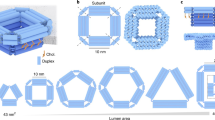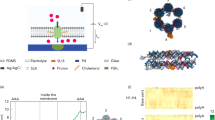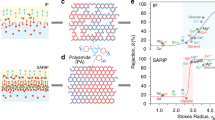Abstract
Recognition of small organic molecules and large biomolecules such as proteins is of great importance in pharmaceutical as well as biological applications. Recognition inside a nanoporous membrane is particularly attractive, because of the advantages associated with ligand–receptor interactions in confined spaces. Classical nanoporous membrane-based separations simply use the difference in size of the analytes relative to pore size in the membrane. In order to bring about selectivity beyond size, it is necessary that methods for functionalizing the membrane pores are readily available. Here, we describe a simple approach to functionalize the nanopores within these membranes using self-assembling and non-self-assembling polymers. We show that these modified membranes separate small molecules based on size, charge and hydrophobicity. We also demonstrate here that proteins can be differentially transported through the nanopores based on their size and/or electrostatics.
This is a preview of subscription content, access via your institution
Access options
Subscribe to this journal
Receive 12 print issues and online access
$259.00 per year
only $21.58 per issue
Buy this article
- Purchase on Springer Link
- Instant access to full article PDF
Prices may be subject to local taxes which are calculated during checkout




Similar content being viewed by others
References
Lakshmi, B. B. & Martin, C. R. Enantioseparation using apoenzymes immobilized in a porous polymeric membrane. Nature 388, 758–760 (1997).
Higuchi, A., Hara, M., Horiuchi, T. & Nakagawa, T. Optical resolution of amino acids by ultrafiltration membranes containing serum albumin. J. Membr. Sci. 93, 157–164 (1994).
Nakamura, M., Kiyohara, S., Saito, K., Sugita, K. & Sugo, T. Chiral separation of DL-tryptophan using porous membranes containing multilayered bovine serum albumin crosslinked with glutaraldehyde. J. Chromatogr. A 822, 53–58 (1998).
Lee, S. B. et al. Antibody-based bio-nanotubes membranes for enantiomeric drug separations. Science 296, 2198–2200 (2002).
Kohli, P. et al. DNA-functionalized nanotube membranes with single-base mismatch selectivity. Science 305, 984–986 (2004).
Appella, D. H. et al. Residue-based control of helix shape in β-peptide oligomers. Nature 387, 381–384 (1997).
Zimmerman, S. C., Zeng, F., Reichert, D. E. C. & Kolotuchin, S. V. Self-assembling dendrimers. Science 271, 1095–1098 (1996).
Tominaga, M., Konishi, K. & Aida, T. Catalysis of nucleobase via multiple hydrogen-bonding interactions: acceleration of aminolysis of 6-chloropurine derivatives by uracils. J. Am. Chem. Soc. 121, 7704–7705 (1999).
Newkome, G. R. et al. Nanoassembly of fractal polymer: a molecular ‘Sierpinski hexagonal gasket’. Science 312, 1782–1785 (2006).
DeLano, W. L., Ultsch, M. H., De Vos, A. M. & Wells, J. A. Convergent solutions to binding at a protein–protein interface. Science 287, 1279–1284 (2000).
Berg, T. Modulation of protein–protein interactions with small organic molecules. Angew. Chem. Int. Edn 42, 2462–2481 (2003).
Xu, H., Hong, R., Lu, T., Uzun, O. & Rotello, V. M. Recognition-directed orthogonal self-assembly of polymers and nanoparticles on patterned surfaces. J. Am. Chem. Soc. 128, 3162–3163 (2006).
Bayraktar, H., You, C.-C., Knapp, M. J. & Rotello, V. M. Facial control of nanoparticle binding to cytochrome C. J. Am. Chem. Soc. 129, 2732–2733 (2007).
Xu, Q.-H. et al. Time-resolved energy transfer in DNA sequence detection using water-soluble conjugated polymers: the role of electrostatic and hydrophobic interactions. Proc. Natl Acad. Sci. USA 101, 11634–11639 (2004).
Jirage, K. B., Hulteen, J. C. & Martin, C. R. Nanotubule-based molecular filtration membranes. Science 278, 655–658 (1997).
Martin, C. R., Nishizawa, M., Jirage, K. B. & Kang, M. Investigation of the transport properties of gold nanotubule membranes. J. Phys. Chem. B 105, 1925–1934 (2001).
Jirage, K. B., Hulteen, J. C. & Martin, C. R. Effect of thiol chemisorption on the transport properties of gold nanotubule membranes. Anal. Chem. 71, 4913–4918 (1999).
Ku, J.-R. et al. pH and ionic strength effects on amino acid transport through Au-nanotubule membranes charged with self-assembled monolayers. J. Phys. Chem. C 111, 2965–2973 (2007).
Hulteen, J. C., Jirage, K. B. & Martin, C. R. Introducing chemical transport selectivity into gold nanotubule membranes. J. Am. Chem. Soc. 120, 6603–6604 (1998).
Chun, K.-Y. & Stroeve, P. Protein transport in nanoporous membranes modified with self-assembled monolayers of functionalized thiols. Langmuir 18, 4653–4658 (2002).
Hawker, C. J. & Wooley, K. L. The convergence of synthetic organic and polymer chemistries. Science 309, 1200–1205 (2005).
Krishnamoorthy, K. & Zoski, C. G. Fabrication of 3D gold nanoelectrode ensembles by chemical etching. Anal. Chem. 77, 5068–5071 (2005).
Yu, S., Li, N., Wharton, J. & Martin, C. R. Nano wheat fields prepared by plasma-etching gold nanowire-containing membranes. Nano Lett. 3, 815–818 (2003).
Yamada, K., Gasparac, R. & Martin, C. R. Electrochemical and transport properties of templated gold/polypyrrole-composite microtube membranes. J. Electrochem. Soc. 151, E14–E19 (2004).
Savariar, E. N., Aathimanikandan, S. V. & Thayumanavan, S. Supramolecular assemblies from amphiphilic homopolymers: testing the scope. J. Am. Chem. Soc. 128, 16224–16230 (2006).
Lvov, Y., Decher, G. & Mohwald, H. Assembly, structural characterization, and thermal behavior of layer-by-layer deposited ultrathin films of poly(vinyl sulfate) and poly(allylamine). Langmuir 9, 481–486 (1993).
Ferreira, M. & Rubner, M. F. Molecular level processing of conjugated polymers. 1. Layer-by-layer manipulation of conjugated polyions. Macromolecules 28, 7107–7114 (1995).
Wirtz, M., Yu, S. & Martin, C. R. Template synthesized gold nanotube membranes for chemical separations and sensing. Analyst 127, 871–879 (2002).
Ku, J.-R. & Stroeve, P. Protein diffusion in charged nanotubes: ‘on-off’ behavior of molecular transport. Langmuir 20, 2030–2032 (2004).
Yamaguchi, A. et al. Self-assembly of a silica-surfactant nanocomposite in a porous alumina membrane. Nature Mater. 3, 337–341 (2004).
Acknowledgements
This work was partially supported by the National Science Foundation Center for Fueling the Future (CHE-0739227) and Nanoscale Science and Engineering Center (DMI-0531171) at the University of Massachusetts Amherst. We thank J. Zimberlin for help with the pressure change measurements during the determination of pore size.
Author information
Authors and Affiliations
Contributions
E.N.S. and K.K. performed the experiments. All authors analysed the data, carried out project planning, discussed the results and commented on the manusript.
Corresponding author
Supplementary information
Supplemantary Information
Supplementary figures and supplementary tables (PDF 277 kb)
Rights and permissions
About this article
Cite this article
Savariar, E., Krishnamoorthy, K. & Thayumanavan, S. Molecular discrimination inside polymer nanotubules. Nature Nanotech 3, 112–117 (2008). https://doi.org/10.1038/nnano.2008.6
Received:
Accepted:
Published:
Issue Date:
DOI: https://doi.org/10.1038/nnano.2008.6
This article is cited by
-
Towards explicit regulating-ion-transport: nanochannels with only function-elements at outer-surface
Nature Communications (2021)
-
Fabrication of carboxyl-functionalized polymer microtubes via RAFT copolymerization of diurea-type xerogel fibers and acrylic acid
Colloid and Polymer Science (2019)
-
Sequential coating of nanopores with charged polymers: A general approach for controlling pore properties of self-assembled block copolymer membranes
Macromolecular Research (2017)
-
Active and biomimetic nanofilters for selective protein separation
Biomedical Microdevices (2010)



